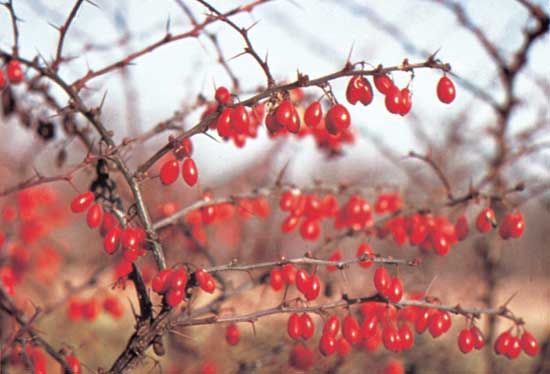What is Barberry?
Also known as: Berberis vulgaris, mountain grape, pepperidge, berberry, common grape
Barberry has a long history of use as a folk remedy for digestive disorders, infection, indigestion, gallbladder disease and heartburn.
The active ingredients in barberry are thought to be the isoquinolone alkaloids, particularly berberine. These alkaloids are found in the root, rhizome and stem bark of the barberry plant.

Why Do People Use Barberry
Diarrhea
Research studies indicate that the alkaloid berberine may fight bacterial, viral, fungal and parasitic infections.
Another alkaloid in barberry, called berberamine, is believed to help fight infections by stimulating white blood cells called macrophages.
In alternative medicine, barberry is used mainly for bacterial diarrhea, traveler’s diarrhea, intestinal parasitic infections and chronic candidiasis.
Barberry capsules are usually recommended, especially those standardized to contain 5 to 12% isoquinolone alkaloids.
Indigestion
When using barberry for indigestion, alternative practitioner recommend a liquid form, such as a liquid extract or tea, because the bitter taste is thought to help it’s medicinal action. It’s usually taken 15 to 20 minutes before a meal.
Liver and Gallbladder Conditions
Barberry is thought to promote the secretion and flow of bile and be a milkd laxative. Although it’s sometimes promoted as a herbal remedy for gallstones, it shouldn’t be used for this condition unless under the supervision of a qualified healthcare professional.
Urinary Tract Infections
One study suggested that berberine may be active against Escherichia coli and Pseudomonas aeruginosa. Some sources say that the berry portion of barberry is more effective at combatting urinary tract infections than the root.
Cultivation
Several species of Berberis are popular garden shrubs, grown for such features as ornamental leaves, yellow flowers, or red or blue-black berries. Low-growing Berberis plants are also commonly planted as pedestrian barriers. Taller-growing species are valued for crime prevention; being very dense, viciously spiny shrubs, they make very effective barriers impenetrable to burglars. For this reason they are often planted below potentially vulnerable windows, and used as hedges.
Culinary uses
The berries are edible, and rich in vitamin C, with a very sharp flavour. The thorny shrubs make harvesting them difficult. Berries are often used in Middle Eastern and European rice pilaf recipes. They are an important food for many small birds, which disperse the seeds in their droppings.
A widely available Ukrainian, Russian, Estonian and Lithuanian candy called Барбарис (Barbaris) is made using extract from the berries, which are commonly pictured on the candy wrappers. Confiture d’épinette was a traditional sweet of Rouen.
Calafate
Berberis microphylla or the similar Berberis heterophylla (both known as Calafate), and Berberis darwinii (Michay) are two species found in Patagonia in Argentina and Chile. Their edible purple fruits are used for jams and infusions; anyone who tries a berry is said to be certain to return to Patagonia. The calafate and michay are symbols of Patagonia.
Zereshk
Zereshk (زرشک) is the Persian name for the dried fruit of Berberis vulgaris (Barberry), which are widely cultivated in Iran. Iran is the largest producer of zereshk and saffron in the world. Zereshk and saffron are produced on the same land and the harvest is at the same time.
The South Khorasan province in Iran is the main area of zereshk and saffron production in the world. Barberry cultivation in Iran is concentrated in the South Khorasan province, especially around Birjand and Qaen. About 85% of production is in Qaen and about 15% in Birjand. According to evidence the cultivation of seedless barberry in South Khorasan goes back to two hundred years ago.
A garden of zereshk is called zereshk-estan.
Zereshk is widely used in cooking, imparting a tart flavor to chicken dishes. It is usually cooked with rice, called zereshk poloRecipe, and provides a nice meal with chicken. Zereshk jamphoto, zereshk juicephoto, and zereshk fruit rolls are also produced in Iran.
In colloquial Persian, zereshk is used as a term for showing dissent or disagreement, similar to the usage of “blowing a raspberry” in English. Although not a vulgar term in that context, it is not used in polite speech.
Iran Medical Herb Exports Iran herb such as Thyme, Saffron, Barberry, asafetida and … to all around the world, for ordering Iranian herbs please visit our Order page.
